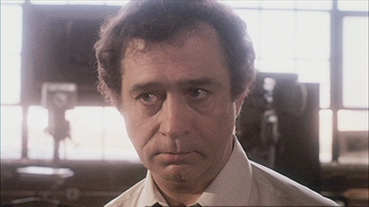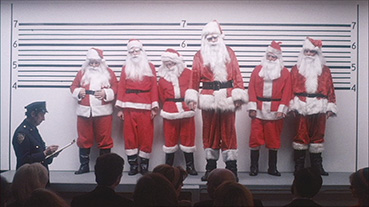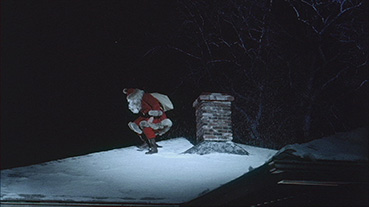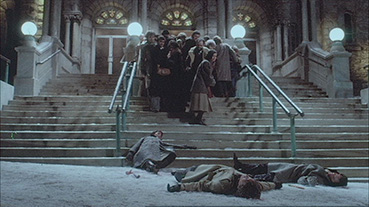| |
"But now I want you to remember to stay good boys and girls. Respect your mothers and fathers, and do what they tell you. Obey your teachers, and learn a whole lot. Now, if you do this, I'll make sure you get good presents from me every year. But if you're bad boys and girls, your name goes in the Bad Boys and Girls Book. And I'll bring you something...horrible." |
| |
Advice given to children by Harry Stadling as Santa |
There's something inherently creepy about the commonly held perception of Santa Claus. Think about it for a second. A large, perennially chortling man with an affection for small children who breaks into your house in the dead of night and leaves presents appropriate to the behaviour of the child, then drinks and eats snacks left for him like a scavenging fox. A fictional creature born of Dutch and German mythology, the currently common conception of him was shaped by illustrator Thomas Nast and appropriated as an evil mascot by the Coca Cola company. When children are small we assure them that Santa Claus is real, yet if they continue to believe in him beyond a certain age we mock their gullibility. I surely can't be the only one who's noticed that "Santa" is a thinly veiled anagram of "Satan".
As someone with an aversion for just about every aspect of Christmas, from its confused religious back story (a supposedly Christian festival celebrated in largely pagan fashion) to its rampant commercialism, I have a particularly dislike for this puffed-up buffoon and his ho-ho-ho. Just occasionally, though, he makes for engaging screen entertainment. In Daryl Duke's criminally undervalued The Silent Partner, a shopping mall Santa turns out to be a sadistic bank robber (Christopher Plummer on deliciously scary form). And what's not to like about Futurama's Robot Santa, a mechanical psychopath who terrifies the populace and spends the night before Christmas exterminating the naughty?

But top of my personal Bad Santa tree have to be two gentlemen named Harry Stadling and Billy Chapman, the Santa-dressed leads of Lewis Jackson's 1980 Christmas Evil (aka You Better Watch Out) and Charles E. Sellier Jr.'s 1984 Silent Night, Deadly Night. Both films spring from the same basic premise, a childhood trauma involving parents and Santa that prompts the witness to later embark on a killing spree, one targeting those he deems to be morally transgressive. But where Sellier's initially neat film dissolves into a straight-up slasher, Christmas Evil is an altogether different fish.
Young Harry Stadling still believes in Santa Claus, despite the claims of his wider-to-the-world brother Phil that it's just Dad dressed up. So imagine Harry's shock when he sneaks downstairs on Christmas Eve and sees Santa giving Mum some very special attention. Thirty-three years later, Harry has developed an obsession with all things Christmas and dreams of becoming Santa himself. Initially this appears to be harmless enough, as he dances around an apartment plastered with Christmas paraphernalia to the strains of Winter Wonderland, and entertains himself by shaping shaving foam into a Santa Claus beard. But in his self-appointed role as the arbitrator of who is naughty or nice, he also keeps tabs on the neighbourhood kids, watching them through their bedroom windows and making notes on their behaviour in books that label them good or bad. In the realms of scenes rendered unsettling by changing times, Harry's binocular-aided spying on pre-pubescent children should be up for a prize. He takes a particular shine to one of the young girls, whom he describes as "just a darling" and whose photo he keeps to coo over and confide with. But Harry is no wannabe paedophile, but a man who really does want to become Santa and whose idolisation of good children is devoid of sexual intent. Even the Jolly Dream company for which he works fits into his fantasy, a manufacturer of cheap plastic toys whose workers man the production line like cheerless elves. That there's a darker side to Harry's obsession is illustrated early on when a workmate's deception sends him into the sort of rage that you usually only see explode within asylum walls. His transformation into Santa also goes beyond the standard seasonal dressing up and guffawing like buffoon, and when he glues on his white beard and cackles wildly at his reflection, it's hard to imagine it's ever destined to come off. As it happens, it never does.

There's no doubt at all that Harry has issues, but thanks to an enthusiastic and committed performance by Brandon Maggart (the father, it transpires, of singer Fiona Apple), he remains oddly sympathetic, particularly when being taken advantage of by bullish workmate Frank or condemned as a weakling by judgemental brother Phil. Like Billy in Silent Night, it does become harder to connect with him once he disappears behind the Santa beard and costume. But unlike Billy, who becomes just another in a line of masked stalk-and-slash killers, Harry walks an altogether less predictable path, one that apparently messed with the heads of those expecting a straight-up slasher on the film's initial release, including the film's backers. Instead of going on the expected killing spree, Harry divides his time between acts of altruistic kindness and brief explosions of furious anger. Thus one minute he's delivering a van full of presents to kids holed up at the local psychiatric hospital, the next he's confronting a group bored attendees at a midnight mass, stabbing one of them in the eye and killing him and his companions with axe blows to the head.
Intriguingly, Harry's actions are not driven by evil intent but a genuine attempt to live up to his chosen new role, his transformation into which is finalised when it snows perfectly on cue while he is delivering presents to the psychiatric hospital. This chocolate-box Christmas scene is sharply undercut by the violence dished out in the scene that immediately follows, one that's robbed of the expected visceral pleasures by its random delivery and the horrified screams of a woman who is spared. And yet a couple of minutes later we're back on Harry's side as he bobs to the music of a Friends and Family party, into which he is dragged by two of the guests (one of whom is played by character actor favourite Mark Margolis, he of Scarface, Pi and Breaking Bad), where he ends up dancing joyously to the delight of the attendees.
This bond with Harry hits a delicious peak quite late in the film (hop ahead a paragraph to avoid minor spoilers) when he's surrounded by a gaggle of excited small children whose parents are aware that he is a killer, and we find ourselves fearing more for Harry's safety than that of the children. Of course by then we know what the anxious parents do not, that the kids are perfectly safe in Harry's presence, and tradition ensures that they instantly feel safe with him. Thus when one parent steps forward to sort Harry out (with a switchblade, no less – who are these people?), the children instinctively form a human shield around him, and when the man's terrified wife wrestles the knife from his hand, his daughter – in what has to be my favourite moment in the film – picks it up and smilingly hands it to Father Christmas.

I'm not going to try and make a case for Christmas Evil as an overlooked horror classic in the mould of Narciso Ibáñez Serrador's brilliant Who Could Kill a Child?, but it's still way better than its low IMDb score might suggest. It's smartly directed – particularly in its use of single-shot takes in the police investigation scenes, which also have some of the niftiest dialogue – is captivatingly photographed by Providence and Time Regained cinematographer Ricardo Aronovich, and includes carefully researched folklore that you'll probably need to listen to the commentary track recognise as such (Harry leaving a sack of dirt at the house of a bad boy and covering his face and hands in mud to leave a mark on his garage door, for example). There's even a dose of humour in the police line-up consisting entirely of part-time Santas in costume, the first shot of which looks like a seasonal out-take from The Usual Suspects. It also boasts an excellent score from Don Christensen, Joel Harris and Julia Heyward, one that intermittently borders on the avant-garde, and a finale that has the brass balls to step outside of reality and into Harry's head and see events purely from his deluded viewpoint. But as Lewis Jackson suggests on the commentary track, by this point in the story we may well have unknowingly been there for some time.
The colour may have faded just a little over time and that earthy tint that marks films as a low-budget product of the 70s or 80s is evident throughout, but in other respects this is a very decent transfer. The picture is clean, the detail crisp and the contrast range well balanced, only softening a little in a couple of the dimmer night shots. The film grain is visible, but has thankfully not been bolstered by obvious edge enhancement, and just occasionally the prime colours pop rather nicely The framing is 1.78:1 (very slightly cropped from the original 1.85:1) and the picture is anamorphically enhanced.

The Dolby mono 2.0 soundtrack lacks the bass kick of a more modern digital track, but is cleanly reproduced and showcases that fine score rather well.
Commentary with Lewis Jackson
Writer-director Lewis Jackson gets off to an energetic start in an entertaining and often fact-busy commentary, providing plenty of engaging background on the making of the film, including how specific sequences were shot and effects were achieved on film's unsurprisingly low budget. I was enthralled to discover that the completely convincing snowfall was created by cutting up white plastic bags into small pieces and blowing them about with a wind machine, and that the assembly line sequences were shot in a real toy factory on the condition that none of the products made by the company would be shown. The influences on Jackson's shooting style prove surprisingly highbrow, ranging from Welles and Lang to Sirk and Fassbinder, and the director usefully points out where shots have been based on famous seasonal illustrations or paintings. There are a few dead spots, but they don't last that long. Good stuff.
Commentary with Lewis Jackson and John Waters
I had very high hopes for this one, given how much I've enjoyed Waters' commentaries on discs of his own movies. It certainly gets off to an enjoyable start, with Waters declaring himself the film's number one fan, highlighting the fetishistic nature of Harry's obsession, and equating his transformation into Santa to a sex change. Jackson repeats some of the info from his solo commentary but adds a few more useful snippets, expanding on the early audience reaction and revealing that George Dzundza was originally up for the lead, but was dropped when he started rewriting the script. Unfortunately, the second half consists largely of Waters taking the affectionate piss out of the film in that way people do when watching a movie that they are unable to take seriously, things like "Oh-oh, that's going to ruin Christmas!" and suchlike. There's even a brief piece recorded by Jackson after the event explaining why Waters spends so much of the time laughing instead of productively commenting on the film. There's good stuff here, but I'd hoped for better.

Lewis Jackson Interview (6:53)
It's always great to put a face to the voice, and while this relentlessly mobile, shot-on-the-street interview by Chad Ferrin (director of Easter Bunny, Kill! Kill! and Someone's Knocking at the Door) does cover some of the same ground as the two commentaries, it is still a tightly packed and engaging seven minutes full of relevant and entertaining info and recollections. Ferrin's response to being asked what scares him is well worth hearing, and his view of the standard of current Hollywood output is pleasingly cynical.
Brandon Maggart Interview (6:41)
Chad Ferrin interviews lead actor Brandon Maggart at his house, sitting next to a costumed fool named Kabukiman, who is labelled here an "out of work drunk." Braggart recalls how he was cast in the film, shares some memories of the shoot, and talks briefly about his admiration for his daughter's music. He spends the last part responding to Troma presents given to him by Kabukiman. Quite fun, but not that substantial.
Deleted Scenes (6:12)
A number of deleted scenes ranging from single shots to entire edited sequences, a couple of which expand intriguingly on Harry's discontent with his workplace superiors (with you there, mate) and his fractious relationship with brother Phil. The clips themselves are in surprisingly decent shape.
Audition Tapes (25:51)
A rare treasure trove of what was and what might have been. Actors auditioning for the roles of Harry, Phil and Phil's wife Jackie include Richard Bright, Carla Borelli, Larry Pine, JoBeth Williams, Brandon Maggart, Pat Hodges, Michael Beck (the chisel-faced lead of Walter Hill's The Warriors), Lindsay Crouse, Jeffrey DeMunn, David Rasche and Ellen McElduff. George Dzundza and Jeffrey DeMunn are also interviewed about their childhood experiences of Santa. Consistently fascinating stuff, the performances here are all impressive enough to give an flavour of how tough it must have been to cast the lead roles. Apparently Kathleen Turner and Glenn Close were also up for the part of Jackie.
Storyboard Sequences
A manually advanced slideshow of scans of some of Lewis Jackson's storyboards for the film, presented two frames per page, which makes it easier to see the detail and read the side notes.
John Waters has described Christmas Evil as "the greatest Christmas movie ever made," and at the tail end of his commentary calls it the one Christmas film he's happy to screen for his friends at this time of year. I'm in full agreement with that second sentiment, though would also throw in Bob Clark's excellent Black Christmas and the aforementioned Silent Night, Deadly Night, albeit with small reservations on the latter. It's certainly a smarter, more entertaining and convincingly played film than its poster artwork might lead the unwary to expect. A solid transfer and a decent collection of fine extra features (the Jackson commentary and the audition tapes in particular) make this required seasonal viewing for the more discerning genre fan.
|